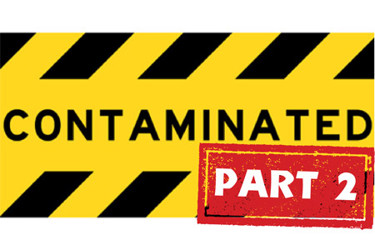All You Need To Know About Contamination Control Strategies, Part 2
A conversation with Vanessa Figueroa and Greg Gibb, Quality Executive Partners

In the second of this two-part series, microbiology and contamination control specialists Vanessa Figueroa and Greg Gibb continue discussing best practices in contamination control strategies through the lens of the newly formalized provisions in the EU GMP Annex I, Manufacture of Sterile Medicinal Products. Check out part 1 of the conversation here.
Can you walk our readers through the elements typically found in a contamination control strategy (CCS)?


The foundational element to consider is the design and validation of the facility, utilities, and equipment. I like to think of these elements as the framing of your entire business, quite literally the foundation of the company. Then come all the processes that are required to run those facilities, utilities, and equipment. And when you develop a process, then those processes themselves require validation and must be monitored and tested to ensure critical process parameters are achieved on a routine basis. Processes must also be run by qualified personnel, and these personnel should be evaluated for their knowledge, technical skills, hygiene practices, aseptic techniques and behaviors, effective gowning, and adherence to overall aseptic culture. Manufacturing processes require materials, various small parts, and containers to ensure that the product comes together and is ultimately delivered in a protected manner. While this is a very high-level overview of the elements to consider when developing a CCS, the key point to realize is that they are all connected, they all require monitoring, and they all have different opportunities for contamination. Annex 1 points out that their collective effectiveness should be considered together, but that when one or more elements are compromised, the entire strategy fails.
What are we ultimately trying to achieve through developing a contamination control strategy?
Figueroa: The goal of a CCS is simple and elegant: identify and understand the various points of contamination in your process, and then try your best to strategically reduce, remove, and prevent future recurrence of that contamination. It is putting the relationships of operations, laboratory, and assurance together in order to provide an effective strategy. While the goal may be simple, the execution may not be; I know this to be true from living these principles in my daily work. However, we are ultimately trying to achieve the safest products for the public, and owning the process, identifying the risks, and then working together to eliminate them is our best shot at delivering those safe products.
Who in the company do you suggest contributes to developing the overall contamination control strategy? And who takes ownership of the document?
Gibb: I know you will hate this answer, but it depends. I would suggest either quality assurance or manufacturing, science, & technology, which has a passion for this type of endeavor. Next, I would direct them to incorporate a team approach to performing the risk assessment so that the site owns the document rather than just an individual. In addition, I think it is a great development opportunity to engage your QC and engineering individuals in this process of establishing the strategy to increase ownership.
Figueroa: In my opinion, it starts with leadership. While most would assume this is a very technical type of strategy (and it is), this type of strategy begins and ends with the leadership at a given company. Making it a priority to understand and prevent contamination from entering the facility, processes, and product must be a priority for a company, and that starts with site leadership. Only once that precedent and mentality is established, then of course you will need a spectrum of technical experts to develop the CCS. This should range from sterility assurance and microbiology experts to facility engineers, process and validation engineers, and the shop floor-level experts, too. Most think this type of strategy is only owned by QC microbiology or sterility assurance folks due to its name, but that’s not true. I believe QA could own this document and facilitate its completion and routine upkeep among all the relevant stakeholders. Contamination control must be part of the quality culture at pharmaceutical manufacturing companies, and that culture is everyone’s responsibility to uphold. This goes for non-sterile manufacturing companies, too.
Once a CCS is established, how often does it need to be evaluated or revised? How should day to day events or investigations influence a site’s contamination control strategy?
Figueroa: I liken the development of a CCS to a living will. When events happen or things change in our lives, we update the will to reflect those changes. Even if no life events occur and all remains the same, we still need to review the will periodically and determine if it remains suitable as we originally intended. A meaningful, strategic document like the contamination control strategy is much the same. It should be treated as a living document that reflects our pharmaceutical process, so it must change when any of the individual elements change but also, in its entirety, the CCS should be evaluated to ensure that it’s working for the company, in the manner originally intended. In all practicality, this looks like an annual review of the CCS to ensure it reflects the current state of the site. Annex 1 suggests that we should have ongoing and periodic review of the CCS, with impact considered as part of other quality system elements, such as change control, investigations, and or regulatory compliance. Be sure to integrate the review of the CCS into a formalized process as part of local procedures; that way, it’s never missed or inadvertently overlooked.
Gibb: It is easy for this document to get lost, so I would suggest that it be built into the organization's procedural review process of once every one to two years. In addition, perhaps make it a part of their annual GMP training so individuals are aware of it and can continue to value all the elements that are critical to a successful program around contamination control.
Do you see regulators requesting to see this document during a facility or product related inspection?
Figueroa: Absolutely. I feel that this is our time to provide tremendous value to the industry in terms of contamination control. In the past decade, the regulatory actions for contamination-related events have increased substantially, and the need to understand and apply the science of microbiology has been very much in demand. Regulators, too, are becoming increasingly knowledgeable in microbiological science, so I firmly believe that a contamination control strategy document will not only be requested but expected to be implemented in a compliant, quality by design, and patient-centric manner. This applies to both sterile and non-sterile products manufacturing, too, as all companies are expected to control bioburden and prevent its entry into their processes and environments. In the past, we may have had different names for this type of document, such as microbial control strategy or bioburden control plan. Nonetheless, the spirit of these documents remains the same and has evolved to now become a regulatory expectation. I could even see the CCS being requested before regulators are even on-site, much the same as annual product review or environmental monitoring trend reports. It’s almost like a mind map into an organization’s overarching approach to quality, and this means companies have a brilliant opportunity to showcase their best efforts forward.
What do you feel is something people often miss or leave out of a CCS?
Figueroa: Oh, this is easy: vendors. I think people most often overlook the vendors that they use, and how those vendors can adversely contribute to the contamination in their process. Whether vendors supply the raw materials for your product, or the supplies used inside the cleanroom, a company should evaluate their vendors and all the controls they have in place to reduce and prevent contamination in the materials they supply. The quality of these materials is then transferred to a company, and ultimately the decisions that vendor makes can affect the cleanliness of the cleanroom or potentially even your product. Annex 1 points out vendor approval, too, stating that it applies to key component suppliers, sterilization of components and single-use systems (SUS), as well as critical service providers. While you may think that a vendor doesn’t apply, this is not true, and they should very much be evaluated as part of a site’s contamination control strategy.
Any last thoughts around the CCS document?
Gibb: I hope that companies will use this time to refresh their existing assessments or to establish their strategies in a manner that is useful and enjoyable. This process of developing the strategy should be fun and a chance to strengthen an organization's control.
Figueroa: My final thoughts are always of support and encouragement. While development of a contamination control strategy may seem overwhelming, the hardest part is getting started. Ideally, this type of document should be developed even before a manufacturing site goes live with production. But if that isn’t the case at your company, just begin as soon as you are able to, and be sure to build a team of experts that can meaningfully contribute to this effort. Know that there are many resources available from industry organizations, or even regulatory guidance documents, so use those to your advantage. If that still seems daunting, then reach out to industry experts for support.
About The Experts:
Vanessa Figueroa is the executive director of microbiology & sterility assurance at Quality Executive Partners, Inc. (QxP) and the owner, chief microbiologist at VVF Science. During her almost 20 years in pharmaceutical quality, she has built a deep knowledge of microbiology and contamination control. Figueroa was one of the co-creators of the QxP Virtuosi learning platform. She is an active and publishing member of several professional organizations, such as the PDA, American Society of Microbiology, and Association for Women in Science.
Greg Gibb, Ph.D., microbiology, is an independent consultant for Quality Executive Partners, Inc. (QxP) and brings with him more than 30 years’ experience leading pharmaceutical/biotechnology partners to FDA compliance in operations. His expertise and experience focus on aseptic processing, quality control, quality auditing, change control, and GMP. Gibb has served in both technical and management roles in API and drug product production processes in the U.S. and internationally.
